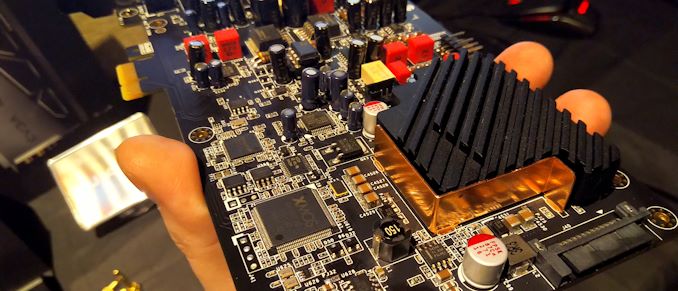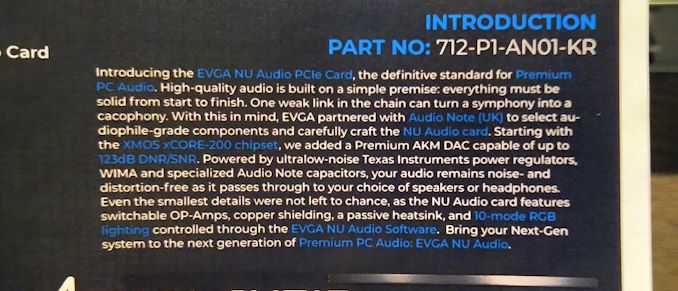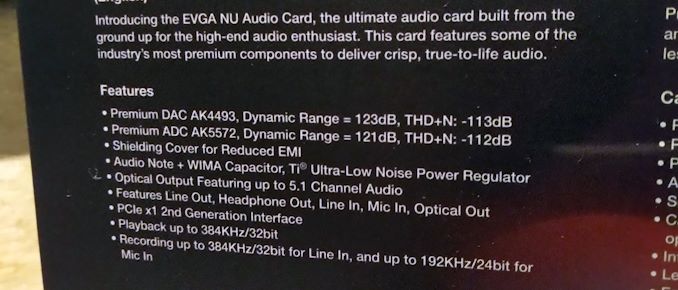EVGA Launches Its First Audio Card, the Nu Audio
by Ian Cutress & Anton Shilov on January 22, 2019 1:00 PM EST- Posted in
- Audio
- EVGA
- Trade Shows
- NU Audio
- CES 2019
- Audio Note

EVGA currently sells a range of products: motherboards, graphics cards, power supplies, cases, and laptops. EVGA has been expanding to other markets for a number of years now, and at CES 2016 we saw the beginnings of a USB audio device due to a collaboration with a professional company called Audio Note. We were impressed at the time, but since then we've not heard much about the project, and had kind of assumed it had been abandoned. But at CES 2019 EVGA introduced the results of the collaboration: its first audio card. This card uses a PCIe to USB controller, making it an internal USB audio product.
EVGA’s Nu Audio card was designed by Audio Note, a UK-based company that develops custom audio solutions. The PCIe 2.0 x1 card implements a PCIe to USB controller to the hardware, and is based on the XMOS xCORE-200 DSP accompanied by Asahi Kasei Microdevices’ (AKM) AK4493 DAC, the AKM AK5572 ADC, and the Cirrus Logic CS5346 ADC. The board uses a silver and gold-plated multilayer PCB with isolated dual ground planes for analogue and digital circuits. Being aimed at users who want a cleaner sound but also better sound support out of their audio outputs, the Nu Audio card uses audio-grade capacitors and resistors that carry Audio Note, Nichicon, WIMA, and Panasonic brands. Besides, it features switchable OP amps as well as a dedicated Maxim amp for headphone volume control.
The Nu Audio card is equipped with two RCA line outs for left and right speakers that can output 384 KHz at 32-bit audio, one output for headphones featuring impedance between 16 and 600 Ohms, an S/PDIF out, a line in supporting 384 KHz at 32-bit audio, and a mic in supporting 192 KHz at 24-bit audio. In addition to traditional analogue and digital outputs, the card supports USB audio class 2.0 enabled by the ASMedia ASM1042 PCIe-to-USB bridge. Meanwhile, to ensure that the board gets enough power, it has a SATA power connector coupled with a multi-stage VRM.
Since EVGA usually targets enthusiasts, its audio card is not only outfitted with a cooling system for heating components, but it is covered by a shroud featuring 10-mode RGB lighting as well as four Audio Reactive Lighting options that match the board’s lighting and audio. The bundled software allows for full EQ tuning, as well as a dynamic response implementation. With the right software, the audio card can support full audiophile formats, such as DSD, and switch between them as required.
EVGA is now currently selling the card, at a price of $249. This is the first in a line of cards, we were told - depending on the feedback of the hardware, the collaboration with Audio Note might extend into a gaming focused design or a more professional audio input/output design.
Related Reading
- EVGA Launches B360 Micro Gaming: Its First Budget Motherboard
- EVGA Releases CLC120 CL11 AIO CPU Cooler: Simple and Affordable
- EVGA Launches SC17 1080 Laptop: Core i7-7820HK, GeForce GTX 1080, TB3
- EVGA Torq X10 Gaming Mouse Review
Source: EVGA
















83 Comments
View All Comments
BinaryTB - Tuesday, January 22, 2019 - link
I'll wait to see what the drivers are like, if the card can work and perform with all features with base-Windows drivers, great! If it requires drivers from EVGA, then pass. Manufacturers always tend to bloat them like crazy and then abandon them after a couple years.Plus for gaming, good luck trying to get every dev studio to QA this card to make sure it doesn't have issues with their game.
I'm speaking from Asus Xonar experience, thankfully the third-party drivers saved that hardware (for now anyway).
coit - Tuesday, January 22, 2019 - link
I use Behringer UCA202. Buy 10 at a time on ebay for $30 each. They have excellent test results.I have more expensive USB DAC's that except for pro balanced inputs are a comparative waste of money.
coit - Tuesday, January 22, 2019 - link
Correction: balanced outputsrpg1966 - Wednesday, January 23, 2019 - link
"The Nu Audio card is equipped with two RCA line outs for left and right speakers that can output 384 KHz at 32-bit audio,"Line-outs output analogue signals, not xxKHz/yy-bits /pedant
Inteli - Wednesday, January 23, 2019 - link
They're clearly talking about the DAC behind the line-level outputs, which is important information.Inteli - Wednesday, January 23, 2019 - link
I'm trying to figure out why EVGA is deciding to get into sound cards right now. I do see a niche for sound cards (areas where space is at such a premium you can't even afford a tiny external DAC/Amp combo), but I don't anticipate the market growing at all.In the internal sound card market, you have to challenge Creative, and I don't see what this offers that Creative's current flagship doesn't for $100 less. The only things that stand out to me are the RCA jacks for the line-output and DSD support, both of which are questionable inclusions to me.
To me, RCA line-level jacks implies that the analog output is going to be connected to some sort of amplifier. If so, why not use the optical out and an outboard DAC, too? As for DSD, it seems like the market for digital DSD files is actually than the market for SACD, which is tiny as it is.
mode_13h - Wednesday, January 23, 2019 - link
The entire audiophile marketplace is filled with products that make little marketing sense. You could imagine a couple guys tearing down some piece of mass market hardware and talking about how they could do much better for just a little more $.My guess is that the business case, if there is one, rests on bigger margins than the rest of their hardware. But maybe it's somebody's pet project and they don't really care if it at least breaks even.
The other thing I'm seeing is bundle deals with the rest of their hardware. Maybe they're planning on using this as the bait to help move their other hardware.
I'm with you on the outboard DAC. That's what I use. Maybe they will also offer an outboard variant of this.
Finally, remember that DSD could virtually blow up overnight, if someone like Spotify decides to offer it.
Inteli - Wednesday, January 23, 2019 - link
I don't think I can see DSD blowing up any time soon, especially not fron Spotify or another mass-market streaming service. Most DACs are designed around PCM, not DSD, and streaming service users (mostly) use their phones or a web browser to listen to music. They won't have a DAC that supports DSD, so the stream would need to be converted to PCM before it could be played. At that point, why not just stream 24/96 PCM files, which require *less bandwidth* uncompressed than 2.8MHz DSD?(96 kHz * 24 bits per sample = 2.304 Mbps, 2.8 MHz * 1 bit per sample = 2.8 Mbps)
mode_13h - Thursday, January 24, 2019 - link
I wasn't predicting it *will* blow up, but just pointing out that in the age of apps and streaming, you don't have the same kind of inertia to overcome that physical discs and retail channels carried.And when I say "blow up", I don't mean it would become massively popular. I just mean that a large catalog of content could become available in the format. So, you could imagine a streaming provider offering a premium "audiophile" service that provides their content in any one of multiple different audiophile formats.
Dubbo07 - Saturday, January 26, 2019 - link
i love how most people who are complaining about this soundcard are not the targeted customers...The RCA output does not imply going to an amp. IT IS for an amp, and it's simple to understand.
Flexibility, if you want to use desktop speakers instead of headphones, OR you want to use a different amp, solid state or tube, and still want to utilize the DAC. The AK4493 DAC is the latest and greatest. The highlights of this product are: AK4493 DAC, custom resistor and capacitors, and the analog volume control! Yes analog volume control.
While I do agree that an outboard DAC would be a better option, this product would cost 2x the price if it's configured that way. No, not 2x, I would say 3x. So in essence, pun intended if you get it, it's a "cheap" alternative for some folks, albeit a small market.
Anything in the "audiophile" market segment is not a big market, i'm sure EVGA has done their market research.